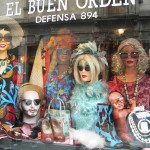BUDAPEST, HUNGARY–It was easy to spot Colm Feore’s Cesarean profile the other day, even far away on horseback on a rural Hungarian field. The actor was draped in a long black cloak and sitting tall in the saddle astride a horse for a battlefield scene for the upcoming CTV/Showtime series The Borgias.
Feore plays relative good guy Della Rovere in the drama set in ancient Rome. He tuned up for the equestrian scenes before coming to Hungary with a few riding lessons near his home in Stratford, Ont.
Feore’s a very cultured man who knows more than a little about everything so I asked him his must see side visits while in Hungary. After a pause, and with some intensity, he singled out the House of Terror, or Terror Haza.
This is not an amusement park ride or some Halloween night attraction; far from it. It is a disturbing, nightmarish place just a few blocks from where CTV had me bunked while in Hungary, the Corinthia Hotel.
Terror Haza is a museum of the horrors forced upon Hungarians in the 20th century, specifically at the hands of the Nazi Hungarian Arrow Cross Party, and later, the notorious Communist terror organization AVO.
The house stands on Andrassy Boulevard, recognized as one of the most beautiful residential streets in the world. It is painted grey on the outside, and is dimly lit and dark throughout inside.
The place houses many artifacts from the Second World War. A German tank, a black squad car, dozens of uniforms and even some period art work. There are many video monitors throughout, many featuring old newsreel footage from the ’40s and ’50s, others featuring interviews with Hungarian Jews who somehow survived the extermination camps.
The dimly lit exhibit areas are small and cramped which adds to the discomfort as visitors shuffle from room to room. Sheets of information, in different languages, are available in each space.
Eventually visitors wind up in a very dark elevator. It descends very slowly while a video monitor plays one more eye witness report from a survivor, who explains in grim detail how prisoners were hanged.
You exit the elevator into a cellar filled with stark stone and cement prison cells. Around one corner is a cramped angular room containing a simple wooden scaffolding, a noose and two small wooden steps.
It is a chilling enough sight but that’s not the worst of it. For these rooms are not recreations. This was the actual house where these atrocities took place.
While that sinks in, one of the last areas you walk through features hundreds of small portraits on a stark red background. These are not the victims, however, these are the faces of the “victimizers.”
The Terror Museum, as the locals refer to it, is such a powerful experience that it is too much for some visitors, particularly those who may have had relatives who suffered within these walls. A room off the main level acts as a place for some to gather themselves, almost as a chapel. There is, believe it or not, a gift shop. Items like fake red Communist passports and candles shaped like Stalin are for sale. If any people are entitled to find black humour in any of this, it is the Hungarians.
Educators and anyone interested can find out more information on the House of Terror here.








